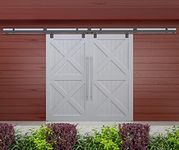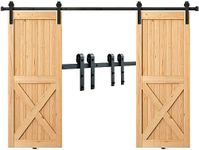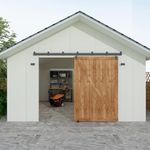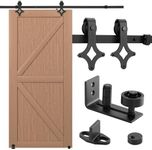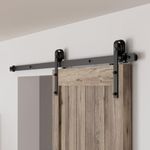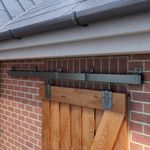Buying Guide for the Best Sliding Barn Door Kits
Choosing the right sliding barn door kit can make a big difference in both the look and function of your space. These kits include the hardware needed to hang and slide a barn-style door, which is a popular choice for saving space and adding a rustic or modern touch to interiors. When shopping for a sliding barn door kit, it's important to consider the size and weight of your door, the type of track, the materials used, and the ease of installation. Understanding the key specifications will help you select a kit that fits your needs and ensures smooth, reliable operation.Track LengthTrack length refers to the horizontal bar that the door slides on. It's important because it determines how far your door can open and whether it will fully clear the doorway. Tracks come in various lengths, typically ranging from 4 feet to 10 feet or more. For single doors, the track should be at least twice the width of your door to allow it to slide completely open. For double doors, you'll need a longer track or two separate tracks. Measure your doorway and wall space to choose the right length for your setup.
Weight CapacityWeight capacity tells you how heavy a door the kit can support. This is crucial for safety and smooth operation. Kits are usually rated for light (up to 100 lbs), medium (100-200 lbs), or heavy (over 200 lbs) doors. Lighter kits are suitable for hollow-core or smaller doors, while heavier kits are needed for solid wood or oversized doors. Check your door's weight and match it to the kit's rating to ensure reliable performance.
Material and FinishThe material and finish of the hardware affect both durability and style. Most kits are made from steel, stainless steel, or aluminum, with finishes like black, brushed nickel, or bronze. Steel is strong and durable, while stainless steel resists rust and is good for humid areas. The finish should match your room's decor and resist scratches or tarnishing. Choose a material and finish that fits your style and the environment where the door will be installed.
Type of MountingMounting type refers to how the track attaches to your wall or ceiling. Wall-mounted kits are most common and require sturdy wall studs for support. Ceiling-mounted kits are used when wall space is limited or for certain design preferences. Consider your wall structure and available space when choosing the mounting type, and make sure you have the right support for safe installation.
Roller TypeRoller type affects how smoothly and quietly the door moves. There are exposed and concealed rollers, with materials like nylon or metal. Nylon rollers are quieter and glide smoothly, making them ideal for bedrooms or quiet spaces. Metal rollers are more durable and suit heavier doors or high-traffic areas. Think about where the door will be used and whether noise or durability is more important for your situation.
Door CompatibilityDoor compatibility means the kit's ability to work with different door thicknesses and styles. Some kits are adjustable for various door thicknesses, while others are designed for specific sizes. Make sure the kit matches your door's thickness and style, whether it's a standard, glass, or custom door. Check the manufacturer's guidelines to ensure a good fit.
Ease of InstallationEase of installation refers to how simple it is to set up the kit. Some kits come with detailed instructions and all necessary hardware, while others may require extra tools or expertise. If you're a DIY beginner, look for kits with clear instructions and customer support. If you're comfortable with tools, you may have more flexibility. Consider your skill level and whether you'll need professional help.





